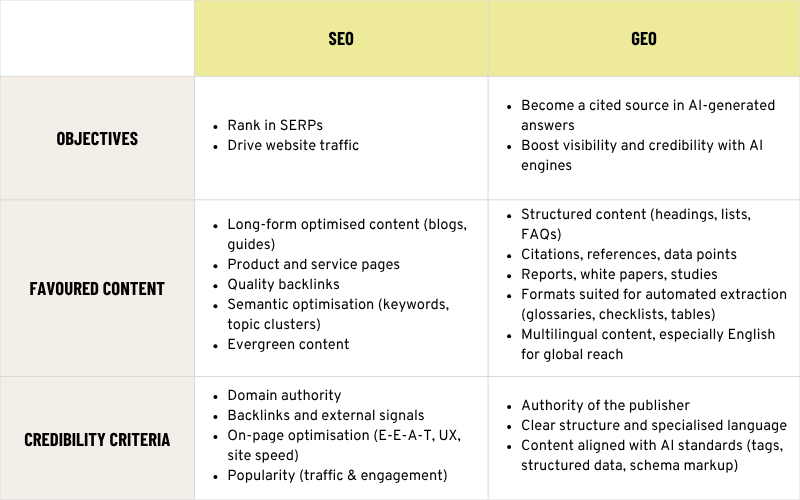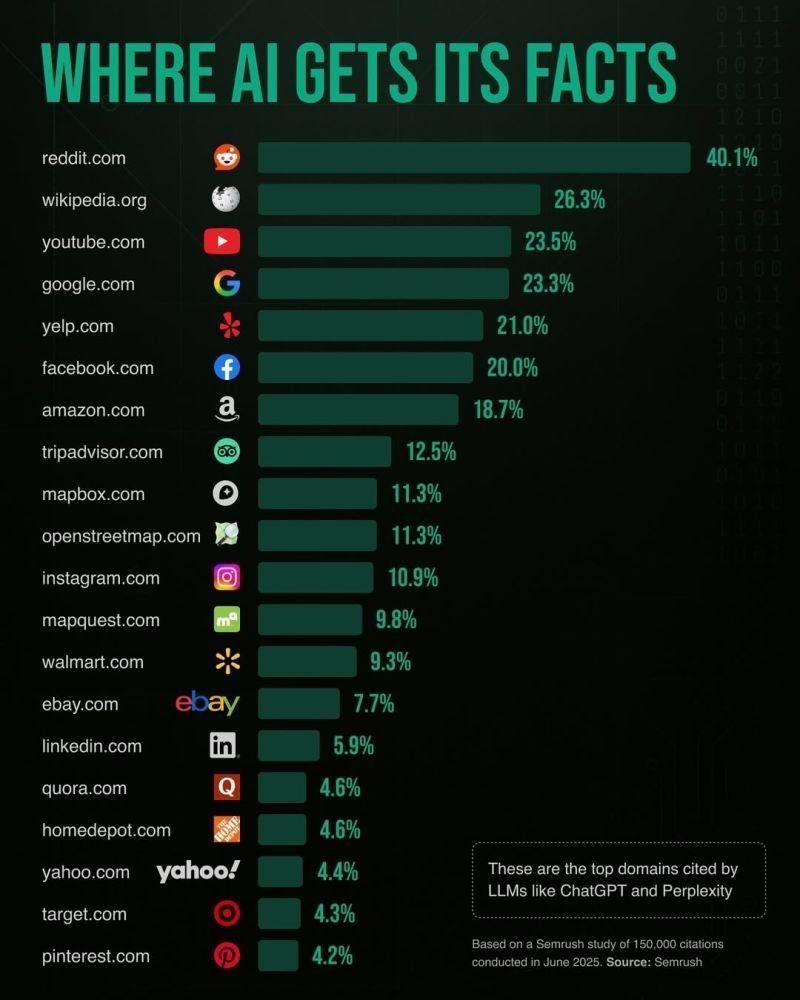For over two decades, SEO has shaped how brands compete for attention online. But a new paradigm is now taking hold: Generative Engine Optimisation (GEO).
The shift is simple but decisive. It’s no longer just about appearing in Google search results. Companies must also be recognised as authoritative sources by generative AI engines such as ChatGPT, Perplexity, Gemini or Claude.
For communication and marketing leaders, the implications are clear: content strategies must be designed not only for traditional search engines, but also for AI models that harvest, summarise and cite.
This article explains what GEO is, how it differs from SEO, and why it is fast becoming a strategic priority. We also share data and practical guidance to help communicators prepare for this shift and embed GEO into their editorial roadmaps.
Speak to a GEO editorial expertI. SEO vs GEO: Understanding the Shift
1. The Logic of SEO
SEO has always been about keywords, site structure, backlinks and technical optimisation (speed, tags, mobile).
The goal: rank higher in search engine results and generate traffic to websites, blogs and product pages.
2. The Logic of GEO
GEO is about ensuring your content is recognised by AI models such as ChatGPT, Claude or Deepseek.
Here, the objective is not just to rank a page but to be cited directly as a trusted reference inside an AI-generated answer.
- Clicks matter less. What matters is being named as the source.
3. The Breakpoint
A Princeton study found that including citations and statistics can increase the likelihood of being referenced in AI answers by up to 40%.
As Andrea Palten, CMO at Techstars, explains:
AI doesn’t rank ten links. It cites, summarises and references the clearest, best-structured sources. If your content isn’t ready, you disappear.
Her three quick wins:
- Write in FAQ style – AI favours clear structures.
- Create “snippet-style” summaries – concise and memorable.
- Prioritise clarity and authority – cite your sources, stay precise.

II. Why Marketing & Communication specialists Must Prepare
1. A Strategic Visibility Issue
According to The Rise of AI Search Archetypes, 75% of people use AI tools more frequently than a year ago, and 43% use them daily.
Brands that don’t adapt risk becoming invisible. As Forbes puts it:
SEO gets you onto a list. GEO makes you indispensable in the answer.
2. A Question of Trust
Generative engines reward content that is credible and authoritative. Danny Sullivan, adviser at Google, notes that Google’s AI Overviews are built on E-E-A-T principles: expertise, experience, authority and trust.
For companies, this means well-documented sustainability reports, expert op-eds or robust white papers can become primary sources cited by AI—boosting both visibility and reputation.
3. An International Dimension
Nearly 90% of AI training data is in English, according to EPFL. For European companies, publishing only in their local language is no longer enough. To stay visible globally, content must also be available in English.
III. GEO in B2B Communication: Best Practices
1. From Keywords to Quotes
Traditional SEO revolved around keywords. GEO rewards content that slots naturally into an AI-generated response.
The formats that work best are short and structured: FAQs, glossaries, checklists, comparative tables. In other words, content built to be copied and cited—not just clicked.
2. Build on Expertise
In B2B, authority is everything. A well-sourced white paper is far more likely to be cited than promotional copy.
Generative engines privilege sources that are clear and verifiable. Annual reports, studies or white papers should therefore be designed as primary references.
3. Multiply Editorial Touchpoints
AI doesn’t just scrape websites. It draws from a broad range of content, including:
- Blog posts
- Infographics and videos
- Case studies and product pages
- Online newsletters
- Podcasts
- Social channels
SEO strategist Neil Patel also highlights the weight of online reviews. Detailed, positive feedback feeds directly into AI training sets.
He stresses the role of digital PR in bringing coherence to this ecosystem. Generative engines pull from media outlets, academic sources, YouTube, Reddit, Wikipedia, LinkedIn and community forums.
- The real differentiator lies in a consistent omnichannel presence. Brands that are active and credible across these terrains boost visibility, build trust and gain a clear competitive edge.

IV. How The Editorialist Helps
A GEO-Ready Approach
At The Editorialist, we are already embedding GEO principles into our clients’ strategies by:
- Producing journalistic, multilingual content,
- Structuring outputs for generative engines (citations, FAQs, data),
- Orchestrating qualified multichannel diffusion,
- Combining SEO and GEO for both immediate reach and lasting authority.
GEO is a tipping point in how online visibility is won.
To stay ahead, companies must publish structured, verifiable and multilingual content that feeds directly into AI-generated answers. SEO still matters—but on its own, it no longer delivers.
Those who adapt early won’t just appear in search. They’ll shape the answers themselves—and in doing so, strengthen both their reputation and their influence with decision-makers worldwide.


